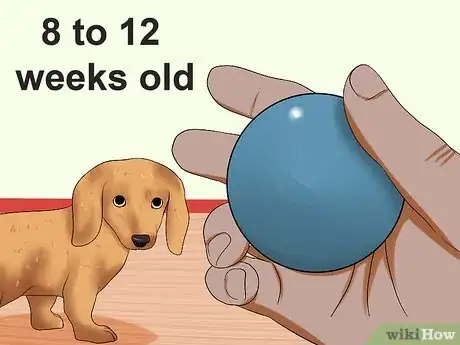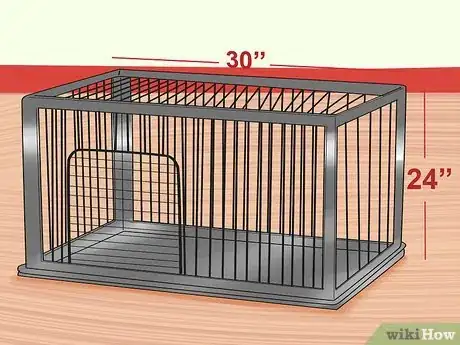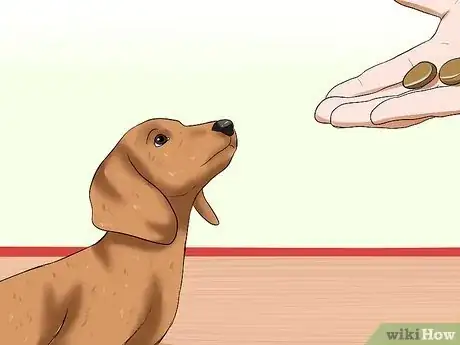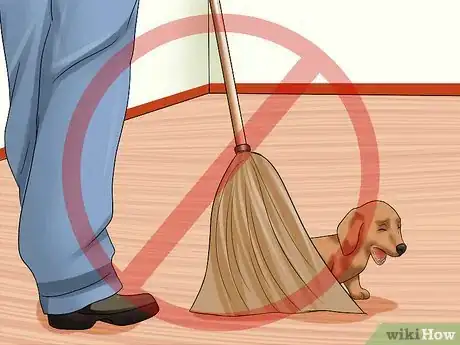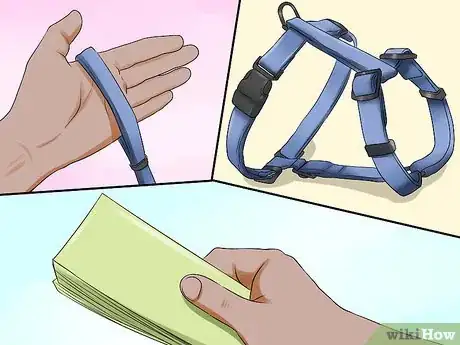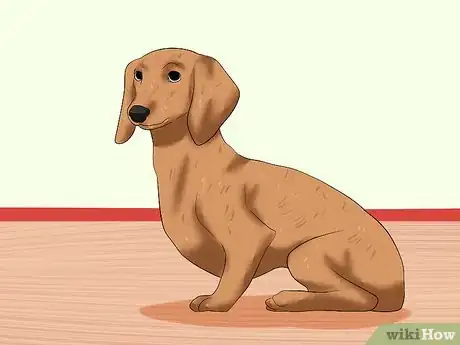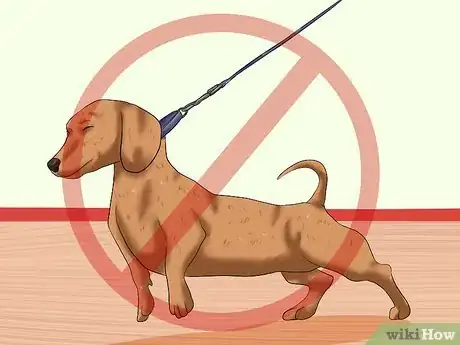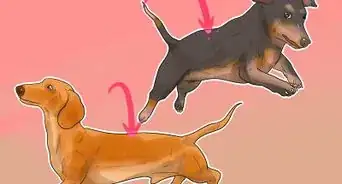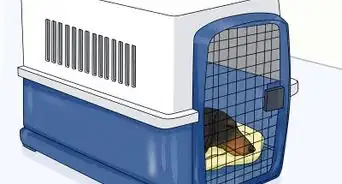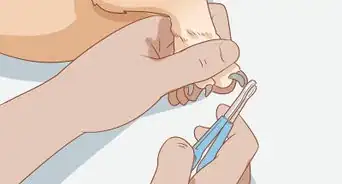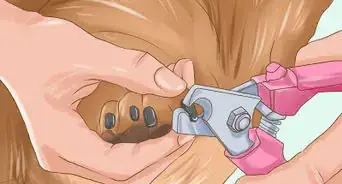This article was co-authored by Pippa Elliott, MRCVS. Dr. Elliott, BVMS, MRCVS is a veterinarian with over 30 years of experience in veterinary surgery and companion animal practice. She graduated from the University of Glasgow in 1987 with a degree in veterinary medicine and surgery. She has worked at the same animal clinic in her hometown for over 20 years.
There are 14 references cited in this article, which can be found at the bottom of the page.
This article has been viewed 83,728 times.
Dachshunds, affectionately known as ‘wiener dogs,’ are little dogs with big personalities. They are playful, affectionate, and energetic. However, since Dachshunds were bred to be independent and think for themselves, they can also be willful and stubborn.[1] Your dachshund’s willfulness may make him difficult to train, but be patient with him—a well-trained Dachshund makes a wonderful companion.
Steps
Training a Dachshund Puppy
-
1Let your puppy acclimate to your home. When you first bring your Dachshund puppy home, you may be excited to start working with him right away. However, he will need anywhere from a few days to a few weeks to get comfortable in your home before beginning training. Confine him to a small area first, such as a small bedroom, then gradually introduce him to your home’s other rooms.[2]
- Keep a close eye on your puppy as he explores his environment. Puppy-proof each room that you let him explore.
- Puppy proofing involves removing or hiding electrical cords, keeping medications and household cleaners out of reach, and picking up children’s toys.[3]
-
2Start training your puppy early. The earlier you start your training, the better. Begin training your Dachshund puppy when he is 8 to 12 weeks old. At around 8 weeks of age, your puppy will have been weaned from his mother, and he will be ready to start experiencing and interacting with the world around him.[4]Advertisement
-
3Enroll your puppy in puppy kindergarten. Puppy kindergarten will allow your puppy to learn how to socialize properly with other dogs. In addition, he will start to learn basic obedience skills in a playful environment, and you will learn how to communicate with him. Before deciding on a class, watch a few sessions to see how the trainer manages the puppies and discourages bullying.
- When your puppy becomes older, enroll him in an obedience class where he will learn some basic commands, like ’sit’ and ‘stay.’
- As your puppy learns how to socialize with other dogs in class, you can also let him meet friendly new people when you take him out on walks. It is important for him to become comfortable with new experiences and people.
-
4Discourage chewing behavior. When it comes to chewing, Dachshunds puppies are no different from other puppies—they love to chew! If you see him chewing on something he shouldn’t (e.g., shoes), say ‘No’ firmly and take the object away from him. Do not verbally or physically scold your puppy for inappropriate chewing. Rather than learning not to chew, he will just become fearful of you, which will make training that much more difficult.[5]
- Say ‘No’ only if you see him in the act. If you say it after the fact, your puppy will not understand why you are correcting him.
- Give the puppy appropriate chew toys and praise him when he chews on them. This teaches him to redirect his chewing behavior to appropriate objects.
Crate Training Your Dachshund
-
1Select a crate. Crate training is an important aspect of training your Dachshund, especially when he is a puppy. Choose a crate that is large enough for comfortable movement, but not large enough for a separate bathroom space. An ideal crate size for Dachshunds is 24 by 30 inches (61 by 76 cm) or 24 by 36 inches (61 by 91 cm).
- Wire crates work well for Dachshunds, since they allow your Dachshund to see what’s going on around him.
-
2Place the crate in an activity-filled area. Dachshunds can get lonely, which could make crate training a challenge. Place your Dachshund’s crate in a room with a lot of human activity, such as the family room. Dachshunds crave companionship, so your Dachshund will enjoy being close to where you and your family spend your time.
-
3Make the crate comfortable for your Dachshund. Ultimately, the crate should feel like a cozy safe haven for your Dachshund. Place comfortable bedding in the crate that already has his scent on it—this will make the crate feel like a familiar place. Put his other ‘creature comforts’ in the crate, such as his food and water bowls and puppy-safe toys.
- Puppy-safe toys are available at your local pet store.
- The crate should be a place of safety and comfort, not punishment.[6]
-
4Encourage your Dachshund to stay in the crate. Throughout the crate training process, which can take at least a few weeks, you will be teaching your Dachshund to remain in the crate for increasing periods of time. Initially, entice him with treats to enter the crate. Then you can start feeding him his meals in the crate.[7]
- Choose a 1-word command (e.g., ‘kennel’) to indicate when you want your Dachshund to enter the crate.[8] Give him a treat whenever he enters the kennel so he can have a positive association with the crate.
- Your Dachshund may whine or cry when you leave him in his crate. Do not give him attention when he does this. If you do, he will learn that whining or crying is a good way to get attention.
- Do not crate your Dachshund all day and night. Not only will he not be able to hold his bladder for that long, constant crating will make him feel lonely and disconnected from you. Consider hiring a pet sitter to spend time with him during the day.[9]
House Training Your Dachshund
-
1Be patient. Given their willful personalities, Dachshunds can be difficult to housetrain. Training your Dachshund to go to the bathroom outside is very important, though, so be patient with him as he learns where he should go potty. It may take at least several weeks to housetrain him properly.
- House training your Dachshund will be easier if you have already crate trained him.
-
2Set up a feeding and bathroom schedule for your Dachshund. Whether your Dachshund is a puppy or an adult, he should be on a set schedule for eating and then going outside to use the bathroom. The schedule will reduce the likelihood of him eliminating in the house. For example, if you have a puppy, feed him 3 to 4 times a day and take him outside immediately after he finishes eating.[10]
- Other recommended bathroom times for puppies are after playing, right before bedtime, and after spending time in the crate. A good rule of thumb to remember is that puppies, up to 9 to 12 months of age, can hold their bladder for 1 hour per month of age.[11]
- Remain consistent with the eating and feeding schedules.
-
3Reward your Dachshund when he goes to the bathroom outside. When you take your Dachshund outside, let him choose the spot where he wants to eliminate. After he finishes, immediately reward him with a small treat and lots of verbal praise.[12] Remain consistent with your praise so your Dachshund will understand that going to the bathroom outside is a good thing.
- Do not rush your Dachshund to potty outside (even if you are in a hurry). He may end up learning to hold it so he can spend more time with you, which will likely lead to accidents inside your home.
-
4Do not punish your Dachshund for accidents. Understandably, you may be upset and/or frustrated with your Dachshund if he urinates or defecates in your home. Rather than punish him after it has happened, clean up the mess without a fuss. Rubbing his nose in the soiled area is not effective—it will serve only to make your Dachshund afraid of you.[13]
- To clean up the soiled area, use a cleaner that will eliminate the odor so your Dachshund does not go back to that same spot.[14]
- If you catch him in the act of urinating or defecating in the house, give a him a firm ‘No,’ pick him up, and take him outside. Praise him when he finishes eliminating outside.[15]
Training Your Dachshund to Walk on a Leash
-
1Purchase a harness and leash. Leash training your Dachshund may be challenging, since he is stubborn and has a natural instinct to chase. A well-fitting harness and leash, which you can purchase at your local pet store, will help you leash train him.[16] Consider having the staff help you select a harness that will fit your Dachshund snugly without being too tight.
- Allow your Dachshund to sniff and explore the harness and leash before you start using them.
-
2Wait until your Dachshund is calm before you walk him. If you put the harness and leash on your Dachshund when he becomes excited about going out for a walk, you are actually teaching him a bad behavior—letting him to do what he wants to get your attention. When you see him become animated, drop the leash and harness and walk away. After he has calmed down, return to him and put the leash and harness on him.[17]
- When you put on the leash and harness, hold the leash in your left hand and excess leash in your right hand.[18]
-
3Do not let your Dachshund pull on the leash. As excited as your Dachshund may be to go out for a walk, do not allow him to pull. This pulling can indicate an attempt to be the pack leader.[19] If he begins pulling, either stand still or walk in the opposite direction.[20]
- If you walk in the opposite direction, do not pull on the leash to get your Dachshund to follow you. Once you start walking the other way, he’ll eventually catch up to you.
- Make sure you remain in front of your Dachshund during the walk to remind him that you are the pack leader.[21]
- Consider giving your Dachshund treats during the walk when he is not pulling to reinforce good behavior.[22]
-
4Teach your Dachshund to heel. When your Dachshund knows how to heel, he will walk beside you without pulling. To teach this command, have him stand on your left side when you have his leash and harness on. Hold the leash in your left hand and a toy in your right hand. Cross your right hand over your body so he can see the toy. Say ‘heel’ and start walking forward, keeping your right hand positioned so he can see the toy.[23]
- Instead of a toy, you could use a treat. Reward him with the treat or toy after about 20 to 30 seconds of him walking beside you properly.
Warnings
- An adult Dachshund can be difficult, if not impossible, to train.[26] If you have an adult Dachshund, you will need a lot of time and patience to train him.⧼thumbs_response⧽
References
- ↑ http://www.dachworld.com/howtotrain.htm
- ↑ http://www.dachworld.com/puppytrainingguide.htm
- ↑ http://www.americanhumane.org/animals/adoption-pet-care/safety/pet-proofing-your-home.html
- ↑ http://www.dachworld.com/puppytrainingguide.htm
- ↑ http://www.dachworld.com/puppytrainingguide.htm
- ↑ http://www.humanesociety.org/animals/dogs/tips/crate_training.html
- ↑ http://www.humanesociety.org/animals/dogs/tips/crate_training.html
- ↑ https://www.pbrc.net/crate-training.html
- ↑ http://www.humanesociety.org/animals/dogs/tips/crate_training.html
- ↑ http://www.humanesociety.org/animals/dogs/tips/housetraining_puppies.html
- ↑ http://www.akc.org/learn/akc-training/how-to-potty-train-a-puppy/
- ↑ http://www.humanesociety.org/animals/dogs/tips/housetraining_puppies.html
- ↑ http://www.humanesociety.org/animals/dogs/tips/housetraining_puppies.html
- ↑ http://www.akc.org/learn/akc-training/how-to-potty-train-a-puppy/
- ↑ http://www.peteducation.com/article.cfm?c=21+1276&aid=157
- ↑ http://www.dogwalker.com/tips-for-walking-a-dachshund/
- ↑ http://thedappleddachshund.com/how-to-leash-train-a-puppy/
- ↑ http://www.dogwalker.com/tips-for-walking-a-dachshund/
- ↑ http://thedappleddachshund.com/how-to-leash-train-a-puppy/
- ↑ http://dogtime.com/dog-health/general/386-leash-training
- ↑ http://www.dogwalker.com/tips-for-walking-a-dachshund/
- ↑ https://www.aspca.org/pet-care/virtual-pet-behaviorist/dog-behavior/teaching-your-dog-not-pull-leash
- ↑ https://www.akc.org/expert-advice/training/puppy-training/teach-your-puppy-these-5-basic-commands/#heel
- ↑ http://www.dachworld.com/howtotrain.htm
- ↑ http://www.dachshundsavvy.com/dachshund-training.html
- ↑ http://www.dachworld.com/howtotrain.htm
About This Article
To train your Dachshund, start by potty training your dog so it knows to go outside to relieve itself. Once it goes potty, give it lots of praise and a treat to positively reinforce its good behavior. You should also discourage it from inappropriate chewing by taking away the item and saying "No" in a firm voice. Then, show it the right thing to do by giving it a chew toy. Additionally, stop your Dachshund from pulling on the leash by standing still or walking in the opposite direction. For tips on how to crate train your Dachshund, keep reading!

